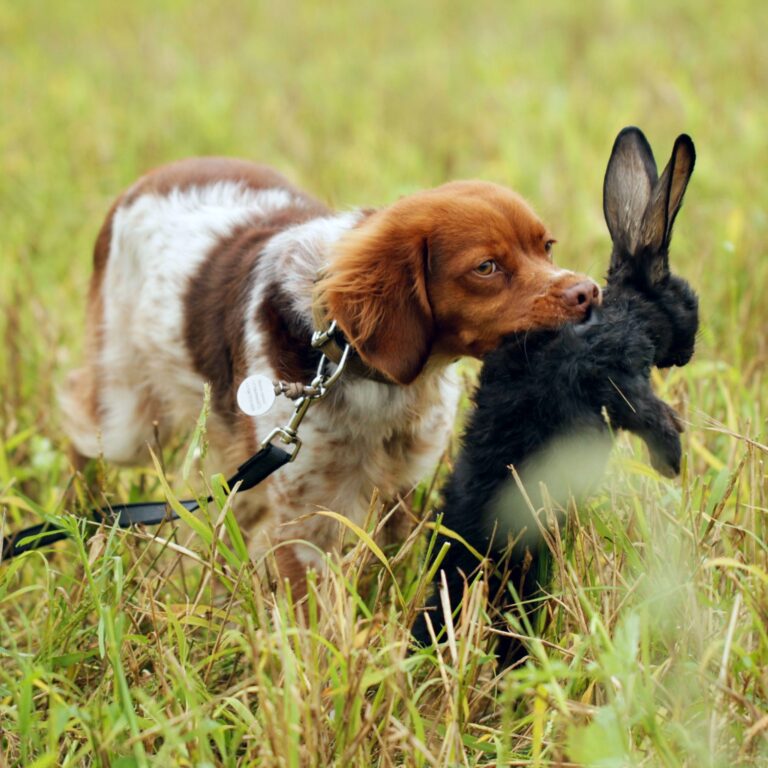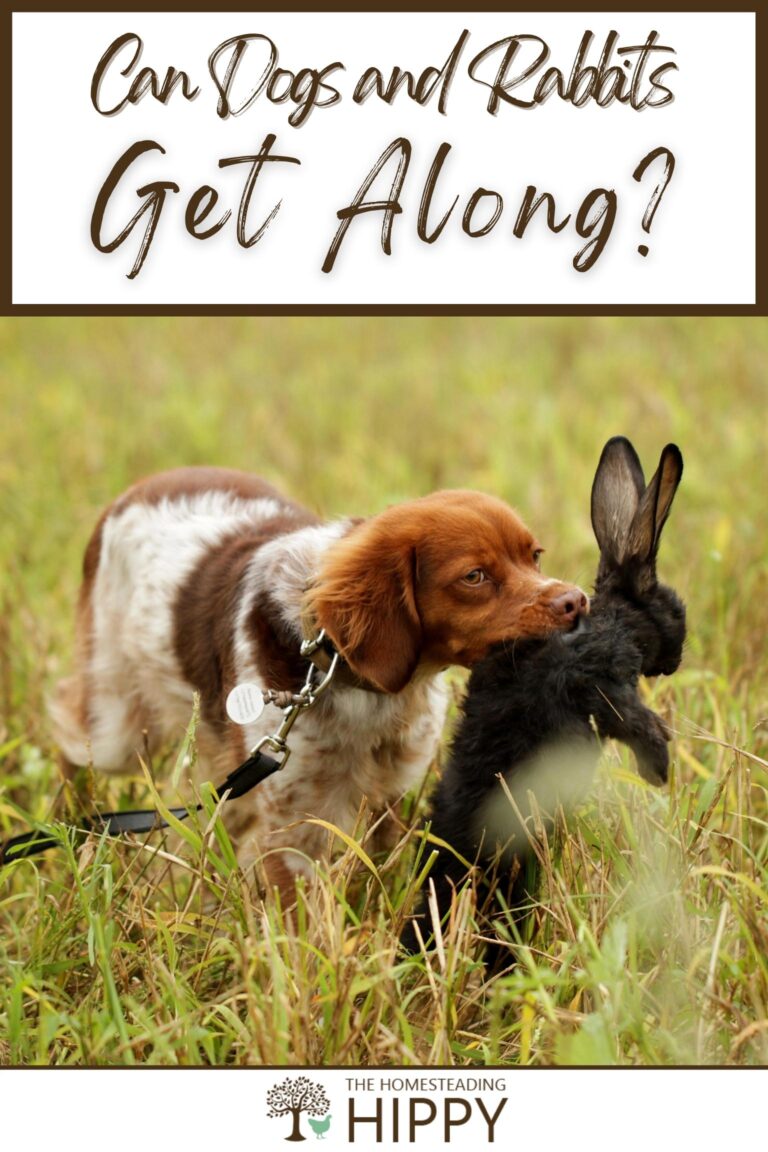If you have a working homestead, or just love having a menagerie of animals for companionship, you have probably wondered if dogs and rabbits can get along.

Both have an undeniable appeal. Both are furry, fluffy, and affectionate. Both are suitable for keeping indoors. But you’d be right to be wary.
Rabbits are prey for pretty much every carnivorous animal in the land, and though our dogs are sweethearts, the notion that something could go wrong is too harrowing to ignore. So, can dogs and rabbits get along?
Yes, dog and rabbits can get along, but ensuring peaceful cohabitation is depending on properly establishing the relationship through bonding.
If you have a pet rabbit and dog, it’s important to socialize them from as young an age as possible so they can get used to each other’s presence and learn to trust each other. Keep in mind that certain dog breeds are far more likely to instinctively attack small animals than others.
It sounds impossible, even a little crazy, but there is plenty of evidence that shows both species being peacefully and playfully acquainted with each other.
However, there are also more than enough gruesome, sad tales of bad outcomes in the same relationship.
This is something you’ll need to consider carefully and approach with diligence if you want success. Keep reading to learn more.
Wild Rabbits and Dogs Definitely Don’t Get Along
In the wild, rabbits are on the menu for just about every canine. Feral dogs, foxes, coyotes, jackals, dingoes, and wolves will all kill and eat rabbits if they can catch them.
Even loose domesticated dogs have been known to do this if given the opportunity. It’s an instinctual behavior that’s passed down through uncounted generations of canines since time immemorial.
Rabbits, similarly, associate canines (and every other carnivore) with only one thing: danger and death. If they cannot elude them by freezing or hiding their only chance is to run for it.
And run they can. A healthy, fit rabbit can easily nearly outrun any dog for a time, except for perhaps a very fast Greyhound or Deerhound.
The good news is that we aren’t talking about wild dogs and wild rabbits. We are talking about our faithful domestic dog and a sweet, floofy domestic rabbit. This fact changes the interaction considerably in our favor, but not totally.
Domesticated Dogs and Rabbits May Get Along if Properly Bonded
The key to getting dogs and rabbits to get along is in the bonding process. This process teaches both animals to associate the other with positive responses and feelings instead of instinctual impulses of “kill” or “run,” respectively.
Bonding is a slow and holistic process that is best accomplished when both animals are young, imprinting easily on “siblings” and owners alike.
That being said, it is technically possible to bond pets at any age, though depending on many other variables the odds could be against it.
Timing Counts for a Lot
As mentioned in the previous section, timing counts for a lot when it comes to bonding a dog and a rabbit for cohabitation. A young adolescent rabbit and a puppy are the ideal matchups with the best chance of success.
Older rabbits and dogs can be bonded as well, but the process may take longer, or in some cases may not work at all.
If you have an adult dog and want to adopt a rabbit, your best bet is to find a young one that can more easily learn to see your dog as part of its family.
I had pet rabbits when I was a kid, though never at the same time as a dog. Raising them from bunnies, they took on personalities much like a dog.
They could mind limited commands, were friendly, calm, and generally everything you wanted in a pet. My neighbors a few houses down bred them and kept many for themselves as pets.
They also had a family dog that got along marvelously with the rabbits. Their dog was raised from birth with and alongside rabbits, and so her whole life she was around them, with no issues.
However, their adoption of an adult dog some years later ended less happily. More on that in a minute…
All Dogs Have a Prey Drive
One thing you must account for is that all dogs, each and every one, from the tiniest Chihuahua to the mightiest Akita, have a prey drive.
Inherited from their wild dog ancestors, the prey drive is what compels a dog to chase, catch, and kill small animals like rabbits.
This hardwired canine behavior can be directed towards any number of other animals – squirrels, birds, lizards, rodents – but the outcome is always the same: chase the small, squeaking thing and bite it.
The animal being chased, naturally, becomes terrified and the dog experiences a sense of satisfaction or elation that quickly results in reinforcement.
Though all domestic dogs by intention have a prey drive that is significantly reduced, it is never truly eliminated, though it might be stifled.
Back to my childhood neighbors’ adopted dog. Taken from a couple who were moving, the dog, a male, intact Jack Russel terrier, was friendly, obedient, and housetrained.
At first, after a period of introduction things seemed fine within the bustling, diverse household.
But one day the dog’s instincts grew too strong, apparently: He killed two of the family rabbits that were allowed to roam the house with the dogs, and left parts of them here and there. The kids were traumatized, and the parents were mortified.
That poor Jack Russel had to find a new family, after that.
Some Dog Breeds Are More Inclined to Pursue Small Prey than Others
Another crucial understanding is that the typical “prey drive” of a dog varies greatly from breed to breed, and even among individuals in that breed.
Sighthounds, for instance, were bred specifically to chase and kill small prey and their entire breeding history revolves around this trait.
Breeds like the Whippet, Greyhound, Ibizan Hound, Afghan Hound, Deerhound, and Saluki have a high prey drive that is difficult to suppress.
On the other hand, some working dogs like the Australian Cattle Dog and Catahoula Leopard Dog were bred to chase and herd but not kill their quarry.
These breeds (and others like them) may be more inclined to “play” with a rabbit rather than see it as prey.
And some breeds, specifically “ratter” or terrier and other small-game hunting dogs are especially likely to “flip” on a rabbit owing to their ancestral purpose.
Though a generalization, since every domestic breed may and probably has been bonded to a rabbit “sibling”, it is important to understand the odds you are up against.
A Well-mannered Dog is a Must
You can set yourself up for success by ensuring your dog, whatever kind, is well trained and utterly obedient to your commands.
If your dog does not instinctively defer to you as the leader of the pack, then it will be difficult to get him to see a rabbit as anything but prey.
The best way to achieve this is through consistent and thorough obedience training from an early age.
If you have an adult dog, there are still things that can be done, but it will be more difficult, and the process may take longer.
A dog that is obedient to your commands will be less likely to chase a rabbit on a whim and will be easier to stop if he does start to pursue one. Training makes it easier to redirect his attention and gives you more control over his behavior.
Calm Dogs are More Likely to be Accepted by a Rabbit
In addition to being obedient, your dog should also be calm and not prone to fits of excitement or aggression.
A dog that is constantly bouncing off the walls, growling, barking, or lunging at passing animals or people is not likely to be accepted by a rabbit and is more likely to stress it out or even hurt it.
Dogs that are overly excited or aggressive are also more likely to see a rabbit as prey in a moment of enthusiasm and may not be able to resist the urge to chase and bite.
A calm, curious dog will make the process far easier, and is more likely to result in positive outcomes.
Introduce Dogs and Rabbits to Each other Slowly
When the time comes to let your dog and rabbit get to know each other, go real slow and take it in baby steps.
Your rabbit should be in a cage or other secure enclosure to guarantee his safety, and your dog should be calm and under your complete control, verbally.
Allow them to sniff each other through the bars of the cage or enclosure, and praise your dog for being calm and interested. If he starts to get too excited, move him away and try again later.
The key is to take it slow and let them get used to each other’s scent and presence before taking the next step.
Do not try to force them to be friends, and do not allow your dog to get too close too fast. This will only scare the rabbit and make him more likely to see your dog as a threat.
The goal is for your rabbit to become comfortable with your dog’s presence, and this trust will take time.
When they are both calm and seem interested in each other, you can try letting them spend time together in the same room, with the rabbit in his cage or enclosure, or out if things are going smoothly.
Always be ready to intervene, and make sure your rabbit has free access to a hidey-hole if he needs some space.
Think Twice Before Leaving a Dog and Rabbit Together
No matter how great things are going, no matter how “tight” your dog and rabbit seem, think twice before you leave them alone together, even in another room.
It is always best to err on the side of caution, and even if your dog has never shown any interest in harming your rabbit, an unsupervised encounter could end badly.
There are too many variables, and it only takes a split second for most dogs to inflict lethal injuries on a nearly defenseless rabbit.

Tom has built and remodeled homes, generated his own electricity, grown his own food and more, all in quest of remaining as independent of society as possible. Now he shares his experiences and hard-earned lessons with readers around the country.
Find out more about the team here.
